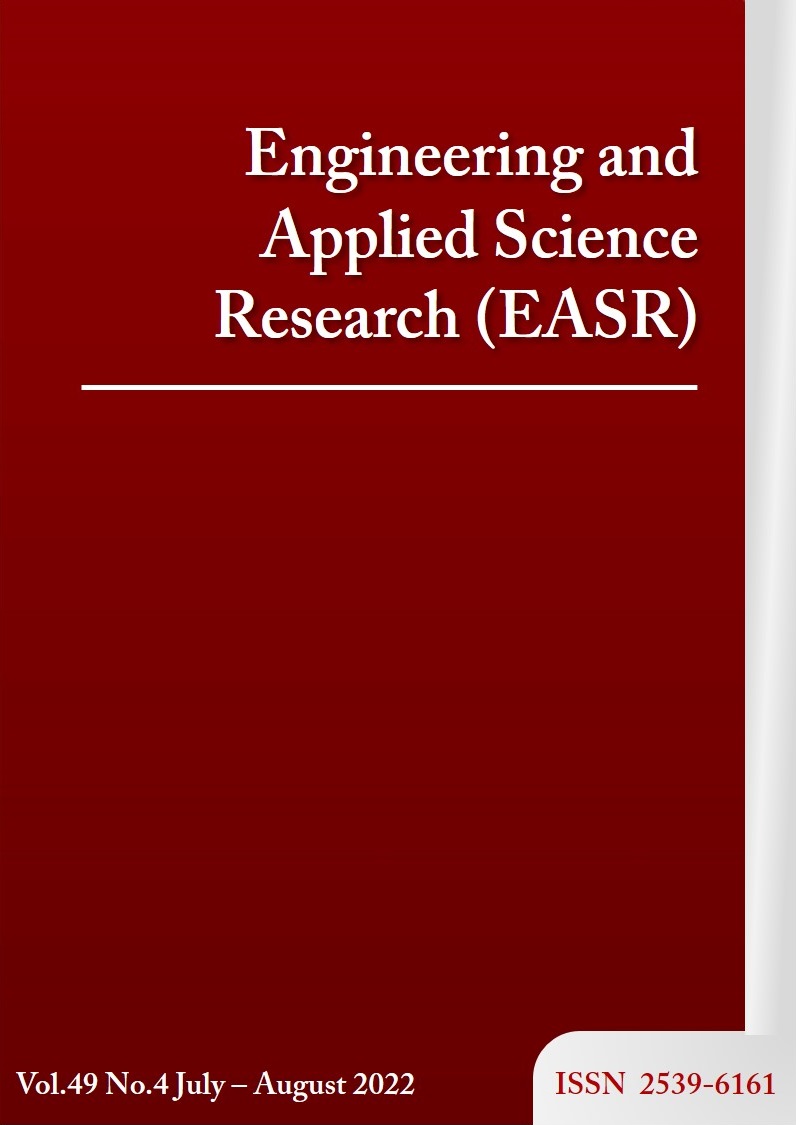Toward 3D reconstruction of damaged vehicles for investigating traffic accidents in Thailand using a photogrammetric approach
Main Article Content
Abstract
Traffic accident investigation by the police forensic science department in Thailand is essential to determine their causes. The collection of forensic evidence from damaged vehicles after an accident plays a significant role in damage assessment and collision trajectory analysis. This study employs a photogrammetric approach using an off-the-shelf mobile device and free software for the three-dimensional (3D) reconstruction of damaged vehicles to investigate traffic accidents. In this study, the iPhone XS Max mobile phone camera was used for image acquisition of close-range photogrammetry and videogrammetry. After image capture, 3D models of forensic evidence were automatically reconstructed from the imagery using the COLMAP open-source software that provides user-friendliness to non-experts. The 3D models of the deformed vehicles were later used to analyze the damage and collision trajectory of a traffic accident. The results showed that for accuracy assessment of the 3D model test car, the values of root mean square error (RMSE) obtained from still images, video, and video with a stabilizer were 2.5, 3.1, and 2.4 cm, respectively. The completeness of the generated 3D model obtained from still images provided greater clarity than videos with and without stabilizers, respectively. Therefore, the photogrammetric approach using a mobile device played a significant role in the 3D reconstruction of the forensic evidence used for traffic accident investigations, providing essential 3D information for court trial reports.
Article Details

This work is licensed under a Creative Commons Attribution-NonCommercial-NoDerivatives 4.0 International License.
This work is licensed under a Creative Commons Attribution-NonCommercial-NoDerivatives 4.0 International License.
References
Houck MM, Siegel JA. Introduction. Fundamentals of forensic science. 3rd ed. San Diego: Academic Press; 2015. p. 3-22.
Villa C, Jacobsen C. The application of photogrammetry for forensic 3D recording of crime scenes, evidence and people. In: Rutty G, editor. Essentials of autopsy practice. 8th ed. Cham: Springer; 2019. p. 1-18.
WHO. Review of Thailand’s status against voluntary global targets for road safety risk factors and service delivery mechanism [Internet]. 2020 [cited 2021 Jul 14]. Available from: https://www.who.int/docs/default-source/thailand/roadsafety/thailand-status-against-12-global-road-safety-performance-targets.pdf?sfvrsn=92a24b06_4.
Pérez JA, Gonçalves GR, Rangel JMG, Ortega PF. Accuracy and effectiveness of orthophotos obtained from low cost UASs video imagery for traffic accident scenes documentation. Adv Eng Softw. 2019;132:47-54.
Lee RL, Wong GME, Wong SYS, Koh ACW. Use of Singapore’s “Standard Details of Road Elements” for distance estimation in traffic crash reconstruction: a comparison with onsite measurements and Google Earth Pro. Forensic Sci Int. 2020;313:110260.
Dustin D, Liscio E, Eng P. Accuracy and repeatability of the laser scanner and total station for crime and accident scene documentation. J Assoc Crime Scene Reconstr. 2016;20:57-67.
Buck U, Buße K, Campana L, Gummel F, Schyma C, Jackowski C. What happened before the run over? Morphometric 3D reconstruction. Forensic Sci Int. 2020;306:110059.
Corcoran KA, Mundorff AZ, White DA, Emch WL. A novel application of terrestrial LIDAR to characterize elevation change at human grave surfaces in support of narrowing down possible unmarked grave locations. Forensic Sci Int. 2018;289:320-8.
Sheppard K, Cassella JP, Fieldhouse S. A comparative study of photogrammetric methods using panoramic photography in a forensic context. Forensic Sci Int. 2017;273:29-38.
Morales A, Sánchez-Aparicio LJ, González-Aguilera D, Rodríguez-Gonzálvez P, Hernández-López D, Gutiérrez MA, et al. A new approach to energy calculation of road accidents against fixed small section elements based on close-range photogrammetry. Remote Sens. 2017;9(12):1219.
Du X, Jin X, Zhang X, Shen J, Hou X. Geometry features measurement of traffic accident for reconstruction based on close-range photogrammetry. Adv Eng Softw. 2009;40(7):497-505.
Kamnik R, Nekrep Perc M, Topolšek D. Using the scanners and drone for comparison of point cloud accuracy at traffic accident analysis. Accid Anal Prev. 2020;135:105391.
Pádua L, Sousa J, Vanko J, Hruška J, Adão T, Peres E, et al. Digital reconstitution of road traffic accidents: a flexible methodology relying on UAV surveying and complementary strategies to support multiple scenarios. Int J Environ Res Public Health. 2020;17(6):1868.
Edelman GJ, Aalders MC. Photogrammetry using visible, infrared, hyperspectral and thermal imaging of crime scenes. Forensic Sci Int. 2018;292:181-9.
Chapman B, Colwill S. Three-dimensional crime scene and impression reconstruction with photogrammetry. J Forensic Res. 2019;10(2):1-6.
Urbanová P, Hejna P, Jurda M. Testing photogrammetry-based techniques for three-dimensional surface documentation in forensic pathology. Forensic Sci Int. 2015;250:77-86.
Leipner A, Obertová Z, Wermuth M, Thali M, Ottiker T, Sieberth T. 3D Mug shot-3D head models from photogrammetry for forensic identification. Forensic Sci Int. 2019;300:6-12.
Zancajo-Blazquez S, Gonzalez-Aguilera D, Gonzalez-Jorge H, Hernandez-Lopez D. An automatic image-based modelling method applied to forensic infography. PLoS One. 2015;10(3):e0118719.
Tóth D, Petrus K, Heckmann V, Simon G, Poór VS. Application of photogrammetry in forensic pathology education of medical students in response to COVID-19. J Forensic Sci. 2021;66(4):1533-7.
Torresani A, Remondino F. Videogrammetry vs photogrammetry for heritage 3D reconstruction. Int Arch Photogramm Remote Sens Spatial Inf Sci. 2019;XLII-2/W15:1157-62.
Calantropio A, Patrucco G, Sammartano G, Teppati Losè L. Low-cost sensors for rapid mapping of cultural heritage: first tests using a COTS Steadicamera. Appl Geomat. 2018;10:31-45.
Luhmann T, Robson S, Kyle S, Boehm J. Close-range photogrammetry and 3D imaging. 2nd ed. Boston: de Gruyter; 2014.
Wang YM, Li Y, Zheng JB. A camera calibration technique based on OpenCV. The 3rd International Conference on Information Sciences and Interaction Sciences; 2010 Jun 23-25; Chengdu, China. New York: IEEE; 2010. p. 403-6.
James MR, Robson S. Straightforward reconstruction of 3D surfaces and topography with a camera: accuracy and geoscience application. J Geophys Res. 2012;117(F3):1-17.
Lim M, Petley DN, Rosser NJ, Allison RJ, Long AJ, Pybus D. Combined digital photogrammetry and time-of-flight laser scanning for monitoring cliff evolution. Photogramm Rec. 2005;20(110):109-29.
Sieberth T, Wackrow R, Chandler JH. Automatic detection of blurred images in UAV image sets. ISPRS J Photogramm Remote Sens. 2016;122:1-16.
Nicolae C, Nocerino E, Menna F, Remondino F. Photogrammetry applied to problematic artefacts. The International Archives of the Photogrammetry, Remote Sensing and Spatial Information Sciences; 2014 Jun 23-25; Riva del Garda, Italy. Goettingen: Copernicus GmbH; 2014. p. 451-6.



